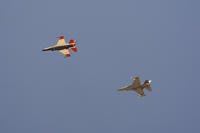George Neil and Bob Yamamoto don't remember exactly where they were when they found out that the Pentagon was canceling their laser cannon project. But they remember how they felt. It was 1988, and Ronald Reagan's "Star Wars" anti-missile effort was in its death-spiral. Their employer, the defense contractor TRW, was competing against Boeing in an increasingly rococo effort to build a Free Electron Laser, or FEL, that would knock missiles out of the sky. But, after a half-billion dollars of investment, the laser in Neil and Yamamoto's lab was peaking out at 11 watts a tenth of what a light bulb generates, and a billionth of what the Pentagon would need. That didn't stop company executives from promising that a weapon was right around the corner. "It was like a game of liar's poker," Neil recalls. "We kept hoping some sanity would prevail. It never did."
It was 1988, and Ronald Reagan's "Star Wars" anti-missile effort was in its death-spiral. Their employer, the defense contractor TRW, was competing against Boeing in an increasingly rococo effort to build a Free Electron Laser, or FEL, that would knock missiles out of the sky. But, after a half-billion dollars of investment, the laser in Neil and Yamamoto's lab was peaking out at 11 watts a tenth of what a light bulb generates, and a billionth of what the Pentagon would need. That didn't stop company executives from promising that a weapon was right around the corner. "It was like a game of liar's poker," Neil recalls. "We kept hoping some sanity would prevail. It never did."
So there was a certain amount of relief when the Pentagon finally pulled the plug as well as anger, and regret. Both Neil and Yamamoto believed in the FEL. Given a shot, they thought, the laser really could stop a rogue missile. Along the way, the breakthroughs required in high energy physics and optics and superconductivity would have far-reaching benefits, even if an ICBM never got zapped. Neil especially hated how reckless promises and politicking and killed that chance. As news of the cancellation sank in, the two colleagues and friends each independently made a promise to himself: If I ever get to build a laser weapon again, next time, it's going to be done right.
My article in the upcoming issue of Popular Science is about Neil and Yamamoto's attempts to stick to that promise, and build lasers that could actually be used for battle.
Ironically, both men have reached back into energy weapons' history to accomplish their goals. In the vineyards of northern California, Bob Yamamoto is constructing a solid state laser with enormous crystals at its core the same way the very first lasers did, back the 1960s. 2,700 miles away, in the forests of southern Virginia, George Neil is putting together a modern-day FEL. It doesnt need any sort of material whatsoever to kickstart its reaction. Instead, the machine relies on a stream of electrons just like the laser he and Yamamoto worked on nearly a quarter-century ago.
UPDATE 11:27 AM: Here's a video of Neil's FEL at work, coring a hole in a plexiglass brick.
UPDATE 11:42 AM: For years, chemical-powered lasers were seen as the only viable alternative for weapons-strength ray guns. The most promising of those systems, the Tactical High Energy Laser, successfully shot down dozens of rockets and mortars. (this video shows it in action.) But generating the THEL's megawatts of laser power required hundreds of gallons of toxic chemicals ethylene, nitrogen trifluoride. The weapons grew bulky (the small-scale version was only supposed to be kept in a mere right cargo containers, each 40 feet long). Worse, after a few shots, the lasers would have to be resupplied with a fresh batch of reactants. The logistics of hauling those toxins either through the air or across a battlefield made generals shiver. So, ultimately, interest swung back to solid state systems, like Yamamoto's, and, to a lesser extent, free electron lasers.
UDPATE 04/14/06 11:33 AM: I know some folks were having trouble checking out those videos. PopSci now has 'em posted in a more watchable format.
Laser Labs Go Back to the Future
© Copyright 2024 Military.com. All rights reserved. This article may not be republished, rebroadcast, rewritten or otherwise distributed without written permission. To reprint or license this article or any content from Military.com, please submit your request here.








